S.L. Viehl's Blog, page 89
May 23, 2014
Gan-Gan
How do you make sense of all the other things that someone leaves behind, the things nobody sees, boxes full of photographs, and bits of string? That's what Gemma Green-Hope asked, and how she did so in the most beautiful way for her grandmother Elizabeth, also known as Gan-Gan:
Gan-Gan from Gemma Green-Hope on Vimeo.
Published on May 23, 2014 04:00
May 22, 2014
Challenge Your Traditions
Every Spring I make new herbal sachets to put in the closets and drawers around the house. It's one of my favorite annual creative projects, and it keeps our small spaces pleasantly fragrant, so I pretty much do the same thing every year: make up little bundles of herbs and spices, sew them into little decorative pillows and bead or beribbon them to death. It's riveting stuff, I know. Next week I'll tell you what I do to get grass stains out of jeans.
This year I started out the same way I usually do, but after I made a couple of sachets I felt a little frustrated with myself. Traditions are great but they can also get really boring. My sachets might be pretty, but after a year they lose their scent and are basically rendered useless, so I always have to replace them. Problem is, there is really only one way to make a sachet. What I needed to do was change my sachet design to be more green.
I like to challenge myself to change things up, even with my best beloved creative traditions, so I went to JoAnn to get some ideas. While I was debating between putting button flaps or zippers in the back of my sachets I spotted this bundle in the bargain bin:

Six canvas mini-totes for ninety-seven cents was a nice bargain, although they were so small they wouldn't be practical for anything but maybe a tiny gift bag, or a doll purse, or a gift card holder, or . . .

Yep, I made them into sachet totes. Inside each one is a little lace packet of herbs and spices:

Thanks to the tote handles, I can also hang them in different places:

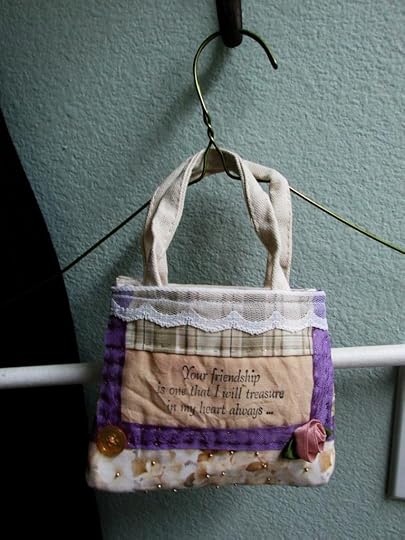
The open top of the sachet tote allows the fragrance to permeat the space where I put them. I love to make totes so that's not a problem, and next year, when it's time to replace my sachets, all I have to do is empty and then refill the lace packets. Nothing wasted, nothing thrown away, and since I used scraps from other sewing projects to make the totes this half-dozen cost exactly ninety-seven cents to make -- you can't even buy them for that little.
As writers we develop traditions with how we work, and this is not a bad thing. Having a routine process generally helps consistency and productivity. Yet no matter how much you love that process, every now and then it's a good idea to take a step back and evaluate not only what you're doing but how you're doing it. Challenging yourself to change may feel scary at first, but the only way to grow is to try something new. Your traditions won't go anywhere, so if you want something better, you have to.
This year I started out the same way I usually do, but after I made a couple of sachets I felt a little frustrated with myself. Traditions are great but they can also get really boring. My sachets might be pretty, but after a year they lose their scent and are basically rendered useless, so I always have to replace them. Problem is, there is really only one way to make a sachet. What I needed to do was change my sachet design to be more green.
I like to challenge myself to change things up, even with my best beloved creative traditions, so I went to JoAnn to get some ideas. While I was debating between putting button flaps or zippers in the back of my sachets I spotted this bundle in the bargain bin:

Six canvas mini-totes for ninety-seven cents was a nice bargain, although they were so small they wouldn't be practical for anything but maybe a tiny gift bag, or a doll purse, or a gift card holder, or . . .

Yep, I made them into sachet totes. Inside each one is a little lace packet of herbs and spices:

Thanks to the tote handles, I can also hang them in different places:


The open top of the sachet tote allows the fragrance to permeat the space where I put them. I love to make totes so that's not a problem, and next year, when it's time to replace my sachets, all I have to do is empty and then refill the lace packets. Nothing wasted, nothing thrown away, and since I used scraps from other sewing projects to make the totes this half-dozen cost exactly ninety-seven cents to make -- you can't even buy them for that little.
As writers we develop traditions with how we work, and this is not a bad thing. Having a routine process generally helps consistency and productivity. Yet no matter how much you love that process, every now and then it's a good idea to take a step back and evaluate not only what you're doing but how you're doing it. Challenging yourself to change may feel scary at first, but the only way to grow is to try something new. Your traditions won't go anywhere, so if you want something better, you have to.
Published on May 22, 2014 04:00
May 21, 2014
Lovecraft for the Ladies Sub Op
Innsmouth Free Press has an open call for female writers only to submit stories for She Walks in Shadows, their first all-female Lovecraft antho: "Submit short stories inspired by the work of Lovecraft that focus on a woman or female deity. It may be a character from Lovecraft’s work or someone of your own creation. You are not restricted to the 1920s as a setting. Steampunk, dieselpunk, noir, and any other sub-genre you can imagine are fine with us. Give us your best and most polished work. And yes, you must be a woman to submit. Women only. To avoid the Asenath effect (that means every character in the anthology would be Asenath Waite), we asked the authors who are contributing stories to pick a different character from a Lovecraft story. While you are not bound to these restrictions, we suggest that if you use a character from Lovecraft’s fiction, you avoid the usual suspects (Asenath and Lavinia). Consider interesting and novel settings for your stories. Surely, strange Lovecraftian entities haunt contemporary Nunavut or the Inca fought strange webbed monstrosities centuries ago. Anne Boleyn, evil sorceress or woman fighting the good fight against the Mi-Go? We may never know. Or maybe we will. POCs are highly encouraged to send stories. Transgender writers: same thing. Stories may be sent in French, English, or Spanish. We can read all three languages." Length and Payment: "Story length is up to 4,000 words with a pay rate of 6 cents a word (Canadian $, eh)." No reprints, electronic submissions only, see guidelines for more details. Deadline: "open submissions period from November 15, 2014 to December 15, 2014. DO NOT SEND STUFF BEFORE THAT DATE."
Published on May 21, 2014 04:00
May 20, 2014
The Center Will Not Hold

While writers obsess over beginnings and endings, to the point that we'll rewrite them five hundred times to perfect them, story middles rarely get such attention. On the contrary, middles are frequently regarded by writers as the Sargasso Sea of storytelling, aka a part of the work that has to be slogged through from the hook of the beginning to the big finish of the end. The problem with this attitude is that it shows in the work; I can't even count how many books I've read that started out well and ended even better, once I waded through 200+ middle pages of filler.
The middle of any story should offer more to readers than characters doing basically nothing but killing time and wordcount. If you find your crew standing around chatting in housekeeping dialogue, thinking extensively in backstory, being served obvious red herrings, or yawning their way through a series of remarkably similar sex/action/suspense scenes, you've likely got a problem. To avoid boring anyone to the point that they give up and chuck the book in the library donation box, writers need to craft the story center to hold onto the reader's attention. Here are some ideas on how to do that:
Conflict Development: Rather than regarding your main conflict as a big problem introduced in the first chapter and resolved only in the last, see it as a stream that runs through the length of your story. Plotters, you can work out a timeline of events that chronicle the development of the conflict to give yourself a map of that stream to refer to when you're writing. Pantsers, look for opportunities to do the same with your stream as you write your way through the story.
Character entrances: Just as we don't meet everyone significant in our lives on the day we're born, there is no rule that says every character in the book has to be introduced in Chapter One (and if there is, someone should put it out of its misery.) Using your story center to introduce some members of your crew adds dimension and interest, and is more logical anyway.
Mid-story twist: The big twist at the end of any book is classic and much beloved, but as a writer you don't have to be exclusive to it. Why not have two (or more) twists, with one (or more) occuring in the story center?
Multiple goals: I think one of the downsides to the Goal/Motivation/Conflict school of storytelling is it turns characters into little goalies incapable of anything but motivationally dancing around in front of that big conflict net. You have more than one goal in your life, yes? So should your characters. And while you can reserve the big goal score for the end of the story, why not give them other, shorter-term goals to work on as well? These can add great interest to your mid-story.
One final thought on writing the middle of your story: if you're not excited about it, it may come through in the quality of your writing. Giving yourself something important, exciting and satisfying to write about in the story before you get into the final chapters will help hold onto your attention, which increases your chance of doing the same with your reader's.
Published on May 20, 2014 04:00
May 19, 2014
Dollar Store Ten
Ten Things I Found at the Dollar Store

1. 6-count 9" X 12" Brown Kraft clasp envelopes
2. 2-count 8-1/2" X 11" bubble mailing envelopes
3. 2-count 6" X 9" bubble mailing envelopes
4. 240-count Premium 2-1/8" X 1/2" Inkjet Mailing Labels
5. 10-count letter-size manila file folders
6. 154-count 9/16" X 2-3/4" file folder labels
7. School composition notebook, 100 ruled sheets
8. 10-count heavy duty binder clips
9. 12-count small/medium/large binder clips
10. Remaindered Books: Burning Tigress in mm paperback, The Recipe Club in trade paperback, and The Actor and the Housewife in hardcover
All of the above items were purchased at my local Dollar Tree store on 5/5/14.

1. 6-count 9" X 12" Brown Kraft clasp envelopes
2. 2-count 8-1/2" X 11" bubble mailing envelopes
3. 2-count 6" X 9" bubble mailing envelopes
4. 240-count Premium 2-1/8" X 1/2" Inkjet Mailing Labels
5. 10-count letter-size manila file folders
6. 154-count 9/16" X 2-3/4" file folder labels
7. School composition notebook, 100 ruled sheets
8. 10-count heavy duty binder clips
9. 12-count small/medium/large binder clips
10. Remaindered Books: Burning Tigress in mm paperback, The Recipe Club in trade paperback, and The Actor and the Housewife in hardcover
All of the above items were purchased at my local Dollar Tree store on 5/5/14.
Published on May 19, 2014 04:00
May 18, 2014
Sub Op
Independent quarterly lit mag Bop Dead City has a contest for flash fic and poetry: "For Issue 8, the theme for the contest is the first time. It’s a pretty loose theme — first job, first house, first kiss, first break-up, and of course, the sex. Prizes: $20 to the winner of the flash fiction category, $20 to the winner of the poetry category, and publication for both. Rules: Just make sure it relates, at least to you, to the idea of the first time for someone or something. Plus, do everything that the usual submission guidelines say. Everything submitted until July 1 that follows these guidelines will be considered for the contest. And of course, even if it’s not the winner, we’ll still consider it for publication as usual." According to their submission guidelines they also accept fiction stories up to 3K -- no mention on payment, so you might query on that. No reprints, electronic submissions only, see guidelines for more details.
Published on May 18, 2014 04:00
May 17, 2014
Online Color Thesaurus
HP has an online color thesaurus which does a couple of neat things when you search the name of a color, like blue:
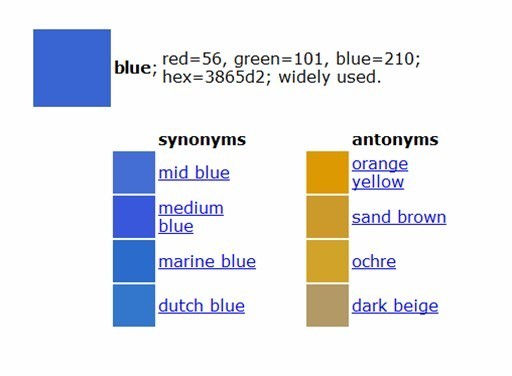
Aside from the helpfulness of providing those color codes, it shows you a swatch of the color, four close matches, and four that are opposing.
This color searcher could be particularly useful when you need to see the color that goes with the word, like chestnut:
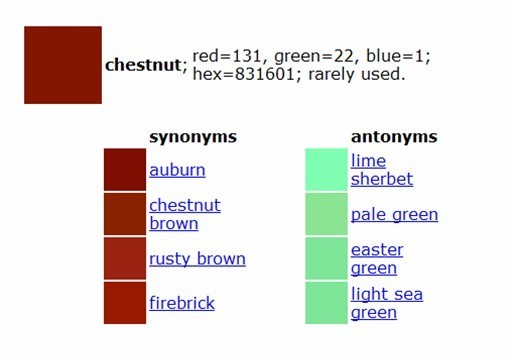
Or celadon:
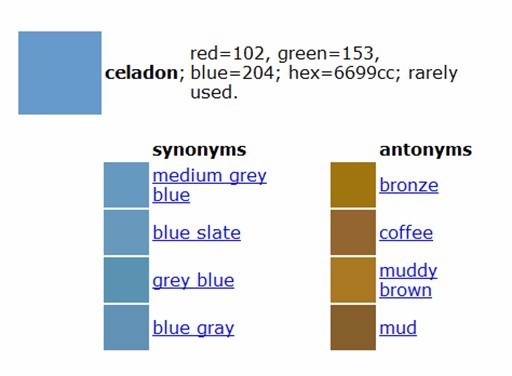
You can also find out if what you think the color looks like is correct; I've always assumed citron meant strong/citrusy-yellow with a slight greenish tinge, when HP tells me it's actually strong citrusy-green with a slight yellow tinge:


Aside from the helpfulness of providing those color codes, it shows you a swatch of the color, four close matches, and four that are opposing.
This color searcher could be particularly useful when you need to see the color that goes with the word, like chestnut:

Or celadon:

You can also find out if what you think the color looks like is correct; I've always assumed citron meant strong/citrusy-yellow with a slight greenish tinge, when HP tells me it's actually strong citrusy-green with a slight yellow tinge:

Published on May 17, 2014 04:00
May 16, 2014
For Kindness and For Love
Instead of the usual Friday video I have a slideshow of a Victorian American scrapbook and poetry journal I recently acquired for pretty much a song off eBay. The poems, written by Rose Bremermann on the last handful of pages, date back to 1889, and are written in that glorious old copperplate calligraphic style.
Rose likely never imagined that her sweet verses -- written for kindness and for love, according to one of them -- would survive 125 years to give hope to another devoted journaler, but they did. Thanks, Miss Rose.
Rose likely never imagined that her sweet verses -- written for kindness and for love, according to one of them -- would survive 125 years to give hope to another devoted journaler, but they did. Thanks, Miss Rose.
Published on May 16, 2014 04:00
May 15, 2014
Dark Sub Op
UK E-publisher Ghostwoods Books would like to see "new and interesting dark fiction novels or cleverly interlinked short stories. Dark fantasy, gothic fiction, dark historical, creepy (but not mindless) horror. No slasher novels, no zombies, probably no YA. Let it be sinister and clever or enchanting yet creepy. Examples of books we would have taken for this call: Frankenstein, Dracula, An Interview with the Vampire, The Night Circus, The Throne of Bones. Note that historical novels must be somewhat updated in writing style to accommodate the tastes of modern readers. (No lengthy, needless exposition or purple prose.)" Length: "mostly between 70,000 and 100,000 words." Payment: 50% royalties. See submissions page for more details.
Published on May 15, 2014 04:00
May 14, 2014
Other Than Writing
I should have mentioned last week that I finally finished my Picasso project. Here's how it came out:

I must admit, it's not perfect by any means, but when you experiment you take risks not only to try things and grow but to make mistakes and learn from them. Which this project did for me pretty much every time I worked on it, but that was part of the fun. I also said I'd give it away here on the blog if it came out well, but I have to welsh on that. Picasso's lady had her own ideas about where and to whom she wanted to go (and I never argue with my projects, especially when it turns out they were right and their timing was eerily perfect.)
I've started on another for-fun quilt project, and I've also been making an effort to shoot some birds (with the camera, of course.) I bagged all of these on the same day:
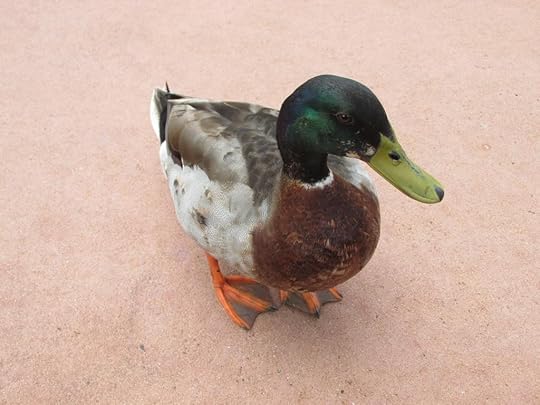


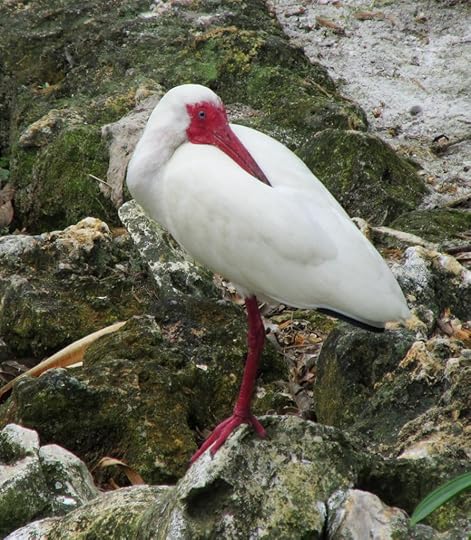
I also finally got a shot of a bunny, plus the bunny's Mom, which any shutterbug will tell you is almost impossible to do:
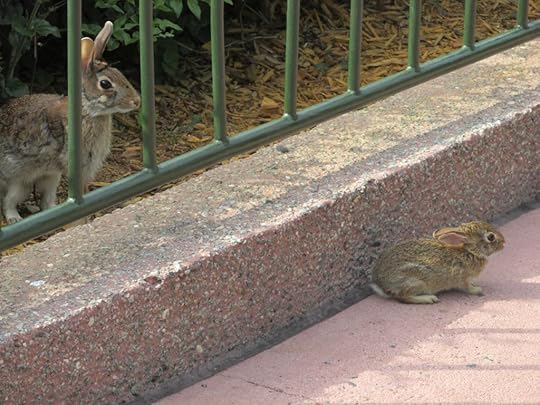
So what are you doing creatively that isn't about writing? Let us know in comments.

I must admit, it's not perfect by any means, but when you experiment you take risks not only to try things and grow but to make mistakes and learn from them. Which this project did for me pretty much every time I worked on it, but that was part of the fun. I also said I'd give it away here on the blog if it came out well, but I have to welsh on that. Picasso's lady had her own ideas about where and to whom she wanted to go (and I never argue with my projects, especially when it turns out they were right and their timing was eerily perfect.)
I've started on another for-fun quilt project, and I've also been making an effort to shoot some birds (with the camera, of course.) I bagged all of these on the same day:




I also finally got a shot of a bunny, plus the bunny's Mom, which any shutterbug will tell you is almost impossible to do:

So what are you doing creatively that isn't about writing? Let us know in comments.
Published on May 14, 2014 04:00
S.L. Viehl's Blog
- S.L. Viehl's profile
- 224 followers
S.L. Viehl isn't a Goodreads Author
(yet),
but they
do have a blog,
so here are some recent posts imported from
their feed.



